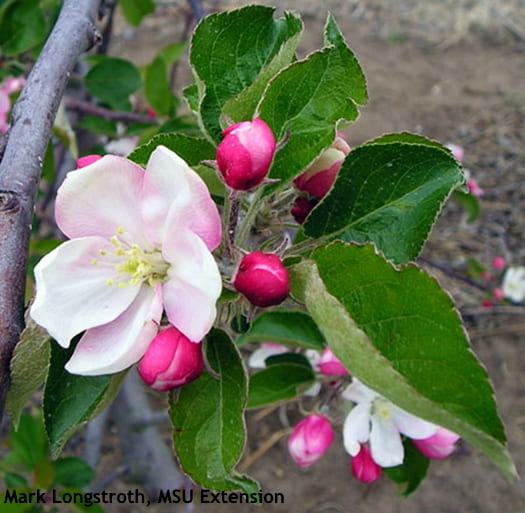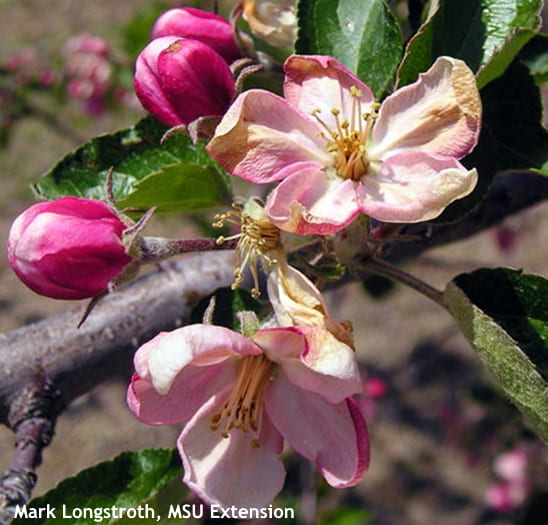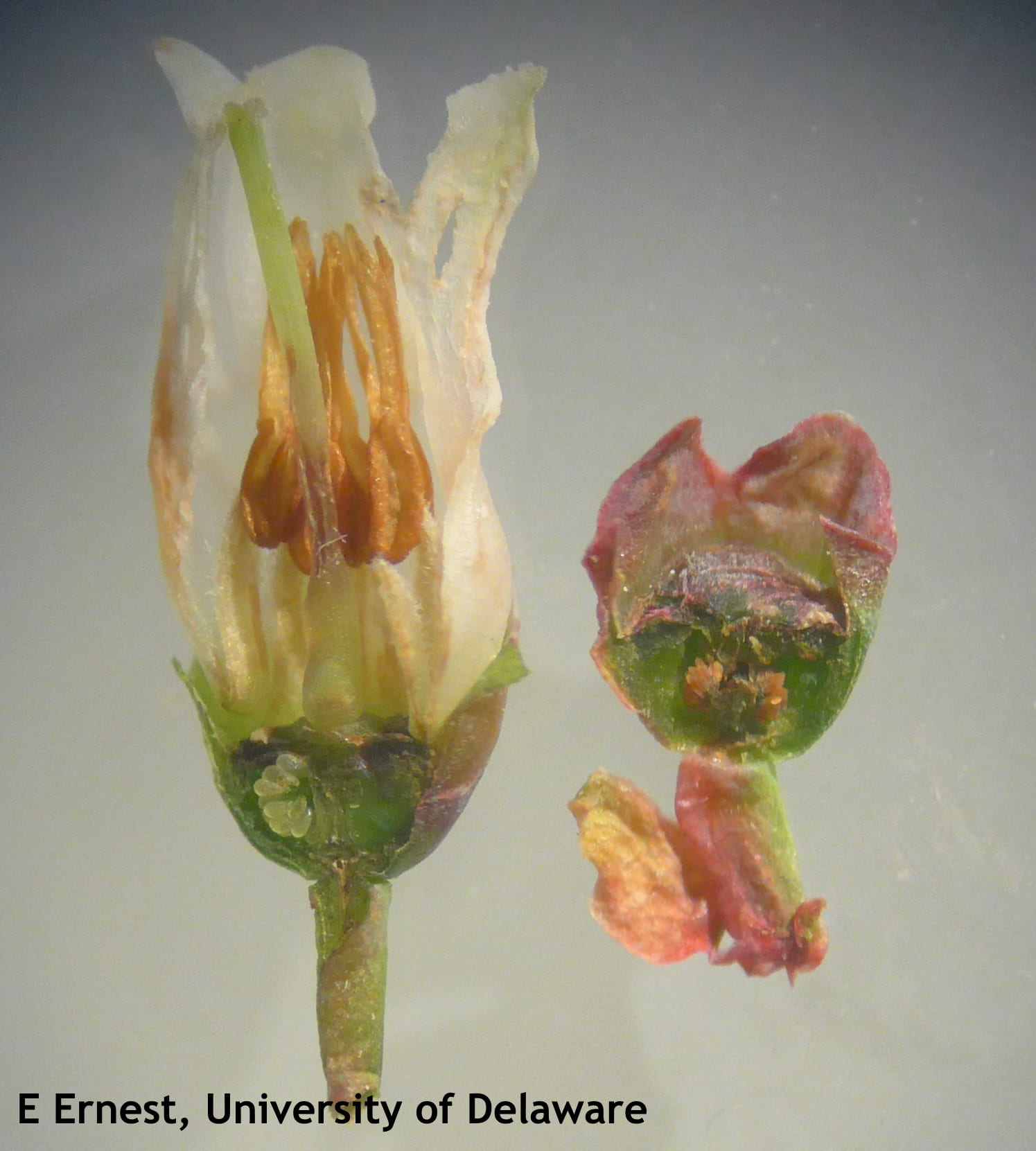Gordon Johnson, Extension Vegetable & Fruit Specialist; gcjohn@udel.edu and Emmalea Ernest, Associate Scientist – Vegetable Crops; emmalea@udel.edu
Freezing temperatures occurred throughout Delmarva over the last 10 days. Cold damage in fruits is a concern.
Stone Fruits
Most peach, nectarine, and plum trees were in Post Bloom Stage over this period, cherries were in various stages of bloom. Research has shown that when stone fruits (peaches, nectarines, plums, cherries) are in the First Pink stage (flower petals coming out of bud but not open), the temperatures required to cause 10% and 90% kill at this bud development stage were 25°F and 15°F, respectively. At First Bloom, the temperatures required to cause 10% and 90% kill were 26°F and 21°F, respectively. At Full Bloom Stage the temperatures required to cause 10% and 90% kill were 27°F and 24°F, respectively and at Post Bloom Stage the temperatures required to cause 10% and 90% kill were 28°F and 25°F, respectively. We will not know the full extent of the damage for several weeks until fruit drop occurs.
Natural fruit drop is a result of unfertilized or poorly fertilized seeds, cold injury, competition between fruits, or shading. Poor pollination may be a result of cold, rainy weather during bloom in self-fertile fruits such as peaches or poor insect pollinator activity during flowering in insect pollinated fruits such as apples. In stone fruit, some fruit that is not fertilized will remain on the plant for 25-50 days after bloom and then will drop before pit hardening starts.
Pome Fruits
Pears were in post bloom stage on Delmarva; however, apples were in various stages of bloom over this period of freezing weather. The following is from Michigan State University:
Apples and pears are very different than stone fruit. The buds of stone fruit trees are either flowers or leaf buds, and not a mixture of both. In cherries and plums where there is more than one flower, all the flowers in a bud are about the same age. In apples, the fruit buds are really small shoots with both flowers and leaves. An apple flower cluster is shown in the photo below. In apples, the flower in the center of the flower cluster is the oldest and most developed and will be the first flower to bloom. This central flower is called the king bloom and is the most desirable of the flowers in the cluster. The king bloom has the potential to be the largest fruit.
The king bloom of the apple flower cluster has opened, but the side blooms are still closed. The king bloom is more susceptible to freeze injury at all stages of the apple bud development in the spring and is often the first flower killed in the cluster.
Since the king bloom is also the most advanced flower in the cluster, it is most likely to be killed in a frost. Another difference between apples and stone fruit is that the pistil is buried inside the base of the flower and not exposed above it as in stone fruit. This means that it is often necessary to tear the flower apart to see if the center of the flower is brown or black. The flower in the photo below is a king bloom killed by frost.
The dark brown center of this apple flower indicates it was killed by a freeze.
When checking apples from frost damage, check the king and side blooms separately. Many times the king blooms are killed and many of the side bloom are undamaged.
The dark brown centers and signed appearance of the petals indicate that both kind and side blooms were killed in a freeze the morning this picture was taken. The king bloom in the center of the cluster has lost its petals.
See this site for a full list of critical temperatures in tree fruit: https://www.canr.msu.edu/uploads/files/TreeFruitCriticalTemperatures.pdf
Strawberries
For strawberries the critical temperature during bloom at the blossom level is 28°F. Below 28°F, there is a progressively higher risk of flower damage, and below 26°F most blooms will be damaged or killed. Flowers that are not open and just emerging from the crown can tolerate temperatures down to 22°F and once fruit has formed temperatures down to 26°F can be tolerated for short periods of time. Flower acclimation is also important. Plants with flowers exposed to several cold days before a frost will be more tolerant than those exposed to warm days before a frost. In addition, not all flowers in a field will have equal risk of damage. Flowers under leaves or near the soil will often be warmer than those higher on the plant or those more exposed.
Blueberries
Some blueberry varieties were also blooming during this period. According to NCState: “For highbush blueberries, when the blossoms are open, a temperature of 27°F for more than a few minutes causes damage. Immediately after corolla drop and before the berry begins to swell is the most sensitive stage. A few minutes below 28°F will result in damage. As the berry begins to enlarge, susceptibility is similar to the critical temperature of 28°F for open blossoms.”
In 2016 there was yield loss in blueberry varieties in the UD variety trial at Georgetown due to a freeze event on April 6 of that year. For most varieties in the trial, yield was half that of the previous year. Only the very late variety, Aurora, did not have reduced yield.
The blueberry fruit on the right was damaged by freezing temperatures and will not mature. Seeds inside the ovary have turned brown. The flower on the left was not frozen, seeds remain plump and green.




